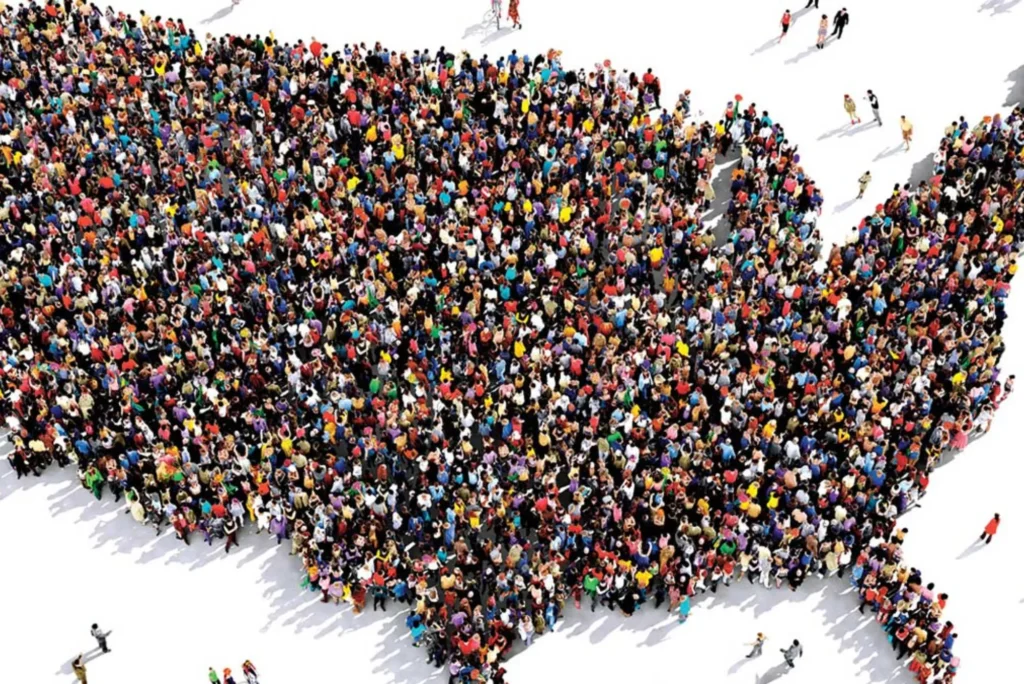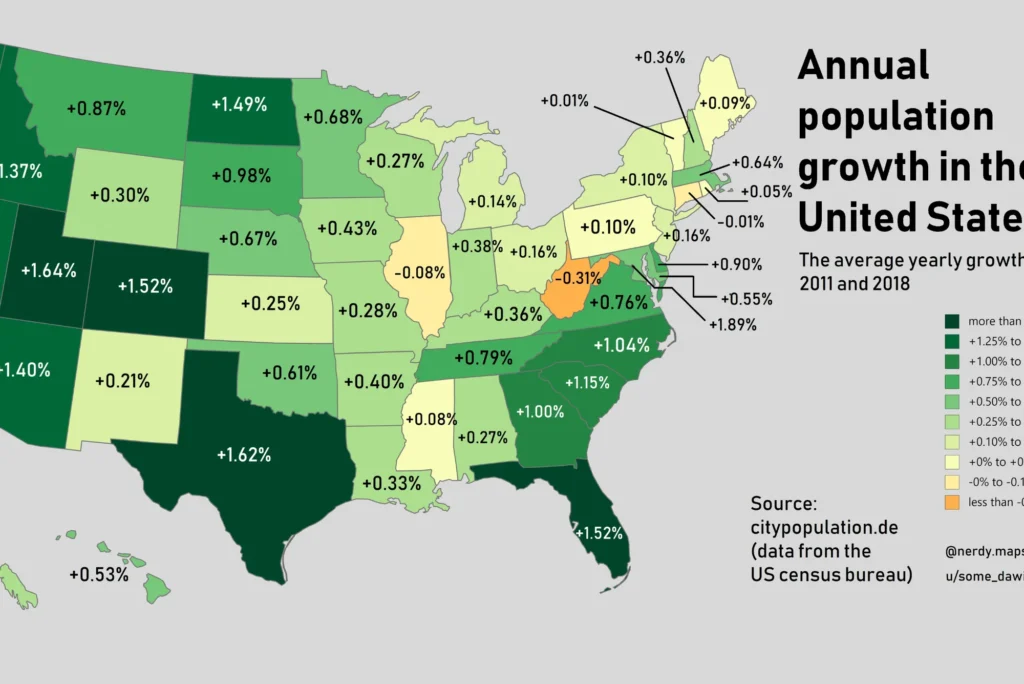The population of the United States of America has been steadily growing and evolving over the years, making it one of the most populous countries in the world. With over 330 million residents, the population of the USA plays a crucial role in shaping the nation’s economy, political landscape, and culture. Understanding the current population of the USA provides insights into its demographic makeup, growth trends, and the challenges that come with such a large population.
Current Population of the USA
As of today, the population of the USA is estimated to be around 334 million people. The United States is the third most populous country globally, following China and India. The U.S. population has grown significantly over the past century, with dramatic shifts in the demographic structure due to factors like immigration, birth rates, and life expectancy.
Historical Population Growth in the USA
The population of the USA has seen remarkable growth since its founding in the 18th century. In 1790, the first U.S. census recorded just over 3.9 million people. Over the next two centuries, the population exploded due to a combination of natural increase and immigration. The rapid industrialization, coupled with improvements in healthcare and agriculture, facilitated this growth, making the U.S. a global economic powerhouse.
- 1790: 3.9 million
- 1850: 23 million
- 1900: 76 million
- 1950: 152 million
- 2000: 281 million
- 2023: 334 million
Key Demographic Trends Shaping the Population of the USA

Several key demographic factors contribute to the growth and composition of the population in the United States. These include:
- Immigration: The U.S. has always been a major destination for immigrants. With policies that encourage foreign-born individuals to settle, the U.S. population has seen a continuous influx of people from around the world, adding to its cultural diversity.
- Birth Rates: Though birth rates have declined in recent decades, they continue to influence the population size. The U.S. is experiencing slower population growth, a trend seen in many developed nations.
- Life Expectancy: Advances in healthcare and living standards have led to longer life expectancy. In 2023, the average life expectancy in the U.S. is approximately 79 years.
- Urbanization: The shift from rural to urban living has been another factor affecting the population distribution. Today, the majority of Americans live in urban areas, with cities like New York, Los Angeles, and Chicago being the most populous.
- Aging Population: The aging population is becoming a significant concern in the USA. With a large portion of the population being over 65, there are increasing demands on healthcare systems and social services.
Population Distribution Across States
The population of the USA is not evenly distributed. Some states have seen rapid growth, while others have experienced slower growth or even population decline. The most populous states include:
- California: With nearly 40 million people, California remains the most populous state in the USA.
- Texas: Texas is rapidly growing and is now the second most populous state.
- Florida: Florida has seen significant growth, driven largely by retirees and migration from other states.
- New York: Although New York’s population has leveled off, it remains one of the most populous states.
- Pennsylvania: While it used to have a larger share of the population, Pennsylvania’s growth has slowed in recent years.
On the other hand, states like West Virginia and Illinois have seen population declines, largely due to economic challenges and migration to other states with more opportunities.
Ethnic and Racial Composition of the Population
The ethnic and racial composition of the U.S. population has become increasingly diverse. The following racial and ethnic groups represent the largest segments of the population:
- White Americans: Comprising about 60% of the population, White Americans are still the largest racial group in the USA, though their share of the total population is shrinking.
- Hispanic and Latino Americans: This group represents around 19% of the population and is one of the fastest-growing demographic segments.
- Black or African Americans: Making up about 13% of the population, Black Americans have had a profound impact on U.S. history and culture.
- Asian Americans: Accounting for about 6% of the population, the Asian American community is diverse, with significant groups of Chinese, Indian, Filipino, and Vietnamese Americans.
- Native Americans and Alaska Natives: Representing just under 2% of the population, Native Americans have a rich cultural history in the U.S.
Age Distribution and Population Trends
Understanding the age distribution of the U.S. population is critical for addressing future challenges related to healthcare, the workforce, and social services. The population can be broken down into several age groups:
- Children (0-14 years): This group represents approximately 18% of the population.
- Working Age Adults (15-64 years): About 63% of the population falls into this age range, contributing to the workforce and economy.
- Seniors (65 years and older): Around 19% of the population is 65 or older, and this proportion is expected to rise due to the aging baby boomer generation.
This aging population will place increased pressure on healthcare and retirement systems, as older individuals typically require more healthcare services.
The Impact of Immigration on the Population of the USA
Immigration has long been a driving force behind the population growth of the USA. Immigrants contribute to the economy, workforce, and cultural diversity of the country. As of 2023, approximately 14% of the U.S. population is foreign-born. Immigrants are crucial in sectors such as healthcare, agriculture, and technology.
Population Growth Forecast for the USA
The population of the USA is expected to continue growing, albeit at a slower rate in the coming decades. By 2050, the U.S. population is projected to reach approximately 400 million, driven largely by immigration and a growing Hispanic population.
Challenges of a Large Population
While the population of the USA offers numerous benefits, such as a large consumer market and a diverse workforce, there are also challenges. Some of the key challenges include:
- Resource Management: With a growing population, managing resources like water, food, and energy becomes increasingly difficult.
- Healthcare: Providing healthcare services to a large and aging population requires significant investment and planning.
- Housing: Rapid urbanization has led to housing shortages and rising costs in many parts of the country.
- Environmental Impact: A large population contributes to environmental challenges such as pollution, climate change, and habitat destruction.
Table: Population Growth of the USA Over the Years

| Year | Population (millions) |
|---|---|
| 1790 | 3.9 |
| 1850 | 23.0 |
| 1900 | 76.0 |
| 1950 | 152.0 |
| 2000 | 281.0 |
| 2023 | 334.0 |
Frequently Asked Questions (FAQs)
1. What is the current population of the USA?
The current population of the USA is estimated to be around 334 million people.
2. How fast is the population of the USA growing?
The population of the USA has grown at a slower pace in recent years, primarily due to lower birth rates and an aging population.
3. What is the racial breakdown of the U.S. population?
The U.S. population is predominantly White (60%), with significant groups of Hispanic or Latino Americans (19%), Black Americans (13%), and Asian Americans (6%).
4. What is the population density of the USA?
The population density of the USA is about 92 people per square mile, which varies significantly between urban and rural areas.
5. How is immigration affecting the U.S. population?
Immigration continues to be a major factor in the population growth of the USA, contributing significantly to its diversity.




